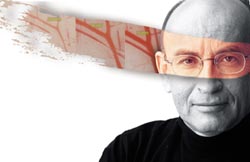Are you a journalist? Please sign up here for our press releases
Subscribe to our monthly newsletter:

Chlorophyll molecules have been selected by nature over billions of years of evolution to help plants and certain bacteria utilize sunlight to drive the production of carbohydrates. Prof. Avigdor Scherz of the Weizmann Institute’s Plant Sciences Department and Prof. Yoram Salomon of the Biological Regulation Department have recently prepared chlorophyll derivatives that might also help save the eyesight of humans.
When the sun’s rays reach plants or photosynthetic bacteria, they interact with chlorophyll or bacteriochlorophyll to turn light energy into electric energy. In the process, highly reactive materials called radicals are created. Though constructive in plants, the radicals’ reactivity is destructive in animal tissue. This distinguishing factor provided the ground for using novel bacteriochlorophyll derivatives for photodynamic therapy (PDT) of vascular-related abnormalities such as cancer and, possibly, the “wet” form of age-related macular degeneration (AMD), which causes blindness in proximately 5% of adults above the age of 65.
AMD is caused by the abnormal growth of new blood vessels underneath the center of the retina (the macula). The new chlorophyll derivatives, when illuminated, generate oxygen radicals that cause the selective destruction of new blood vessels. This approach has already been found promising for vascular targeting treatment of tumors and is undergoing clinical trials on local prostate cancer. Preclinical studies in relation to AMD are in progress.

Prof. Scherz’s research is supported by the Charles W. & Tillie K. Lubin Center for Plant Biotechnology, Mr. William DeWoskin, Chicago, IL, and Mrs. Sharon Zuckerman, Toronto, Canada. He is the incumbent of the Yadelle and Robert N. Sklare Professorial Chair in Biochemistry.